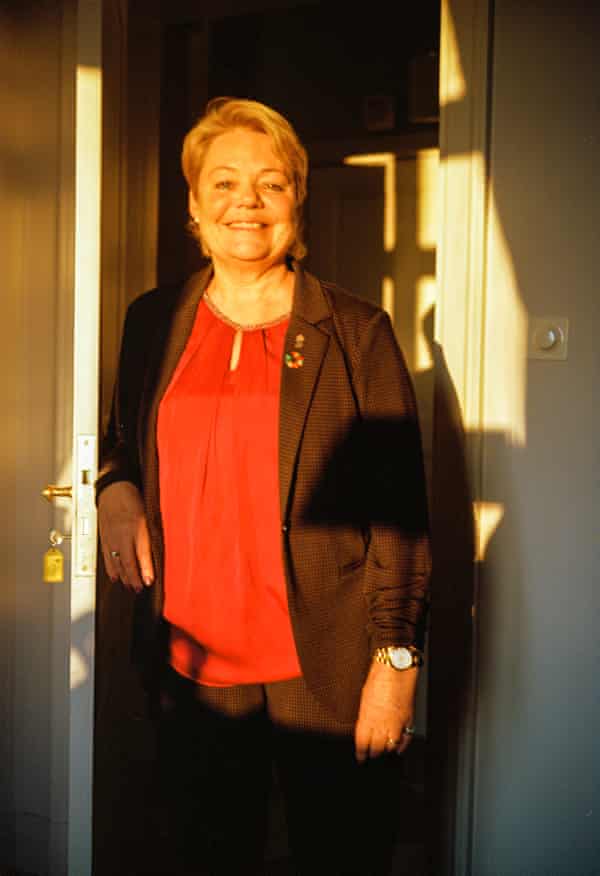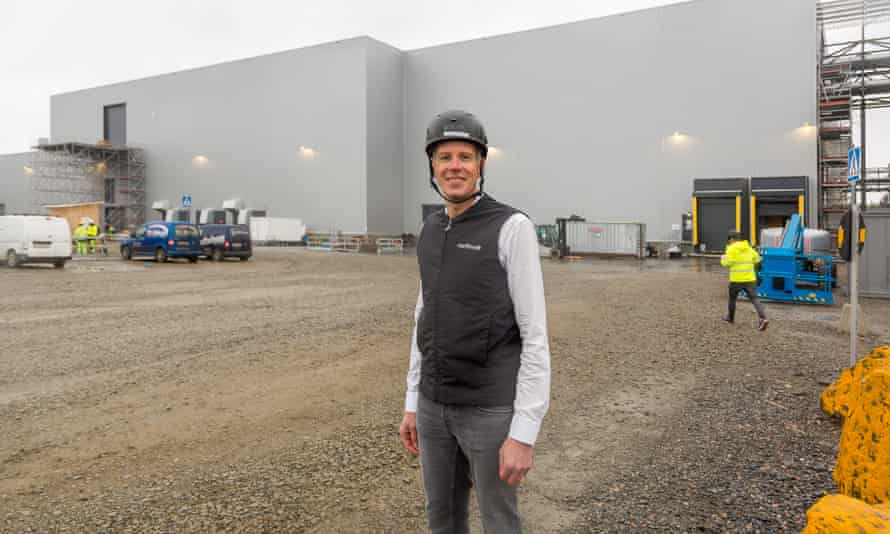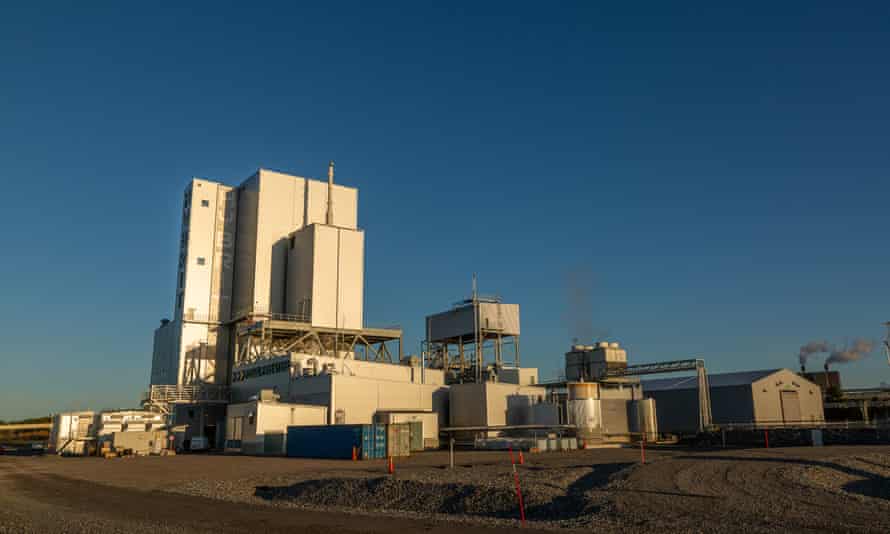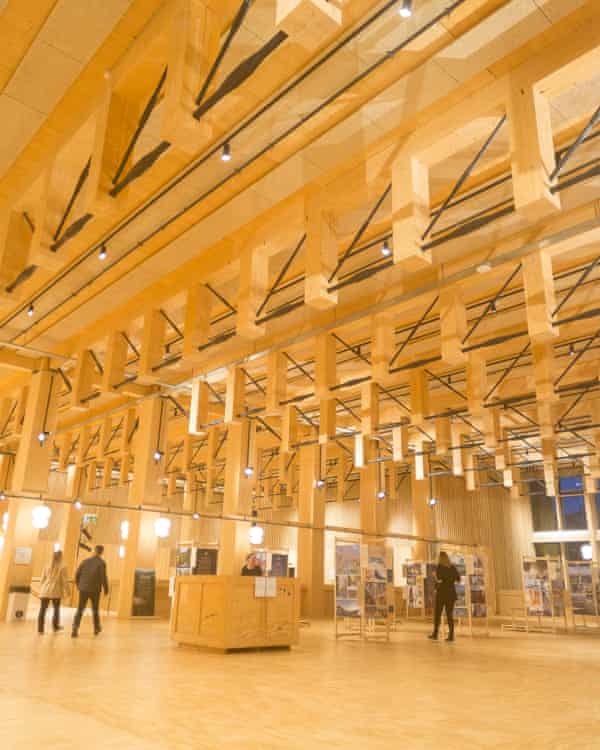Wanted: 100,000 pioneers for a green jobs Klondike in the Arctic

Europe’s newest industrial megaprojects are relocating to the far north of Sweden. But are curling, wild reindeer and the northern lights enough to convince workers to follow?
One by one, the 20 engineers and technicians step up to receive their equipment before the briefing. They have come to the far north of Sweden from as far away as Mexico, the US, Saudi Arabia, China, Germany and Russia.
“Welcome!” bellows Hakan Palsson, their instructor. “We’re here to show you how to do curling, and then you’re going to go out on the ice and show us.”
This is the fourth curling session for new arrivals organised by staff at Northvolt, a company whose car battery gigafactory is rising at breathtaking speed on the outskirts of Skelleftea, this old gold-mining city just 200km south of the Arctic Circle.
The company, the city and the local Vasterbotten county are doing everything they can to help arrivals get comfortable. This summer there was a foraging and wild cooking event for German engineers considering the move north. Locals are instructed to be friendly: “You are going to see more new faces in Skelleftea than ever before,” runs an encouraging post on the city website. “Their experience of Skelleftea will, to a large extent, depend on how good we are at welcoming them.”
Most impressive of all is the 20-storey Sara Cultural Centre, which opened last month. One of the tallest wooden buildings in the world, it has two theatres, a gallery, a library and a luxury hotel.
The reason for all this effort is simple.
If Northvolt is going to succeed in its plans to build Europe’s biggest battery factory, it and its host city need to convince thousands of people to move to the edge of the Arctic Circle, to a region where snow cover is constant from November to April and where the winter sun shines for no more than four hours a day.
The gigafactory is just the most advanced in a succession of green industrial megaprojects springing up all over Sweden’s far north, lured by cheap, renewable energy, vast tracts of undeveloped land and funding from the European Green Deal. Development locals compare it to Dubai or the Klondike gold rush.
About 160km north in the city of Boden, H2 Green Steel starts work next year on the world’s first industrial-scale, fossil-free steel plant. Next door to that, Spain’s Fertiberia plans to spend EUR1bn on a giant electrolysis plant for green ammonia, which will be used to produce fertilisers. A further 200km north in the Arctic mining town of Gallivare, the mining company LKAB will next year embark on a GBP35bn, 20-year project to switch to fossil-free sponge iron, using hydrogen technology successfully trialled this year at the Hybrit steel plant in Lulea.
Reverse migration
What these projects are all desperately short of, more than money, renewable electricity, space or permits, is people.
“The weakest link in the chain is the workforce,” says Lotta Finstorp, the governor of the local Norrbotten county and recent arrival from Stockholm. “If we can’t get people to move up here, we won’t be able to succeed with all these very necessary investments for the world.”
Sweden’s government estimates that the new projects and their suppliers will create at least 20,000 jobs, with 20,000 extra public sector workers needed, and 10,000 to work in shops, cafes and the like.

In total, Sweden’s two most northerly counties could gain 100,000 people in 15 years, boosting their population by a fifth, according to Peter Larsson, the man the Swedish national government has appointed to coordinate this transition. It’s a remarkable ambition given that not so long ago, unemployed people were being paid to move south for work. Larsson thinks the key to achieving reverse migration is to convince people “that this is the best place on earth to live”.
For Liliana Celedon, a 28-year-old engineer from Mexico, it’s an easy sell. Skelleftea is about as exotic as it gets for someone from a sprawling, car-based city on the US border. “I’ve been hiking, swimming in the ocean, and just spontaneously being with nature,” she says.
Outside the Skelleftea Arena, where the curling is happening, the first, slushy snow of the year has just started to fall, and she’s looking forward to downhill and cross-country skiing in the city centre. For Benjamin Linden, from southern Sweden, curling is fun but culture a necessity. Unusually for someone in construction, he started his career as a theatre director, and the day before the curling, he was checking out some improvisational stage shows at the Sara Cultural Centre.
“It’s an absolutely important part of my life to have [theatre] available,” he says. “I actually called the theatre before I came up here, because I wanted to know what they had. Now with the Cultural Centre I really think it will be a lot better.”

Finstorp suspects it will be harder to appeal to southern Swedes, like Linden, among whom northerners have a reputation for being obsessed with hunting, snowmobiles and snuff tobacco, and for being literally less than monosyllabic, dispensing even with the word “yes” in favour of a sharp intake of breath.
Alistair Coley, a 25-year-old cell process engineer from Sunderland in the UK, has found making friends here surprisingly easy. “Everyone you meet does at least say ‘hello’,” he says. He arrived in February with his fiancee, Claudia, and their two cockapoos, Primrose and Albert. “They’re interested in what you’re doing, so I think it’s not necessarily the Swedish stereotype that you get in the north. They want you to be here.”
They were in contact with a local couple before they left the UK, and have since been invited to regular meals and hikes. “We met them, weirdly enough, through the dogs’ Instagram accounts,” Coley says.
Since then, they’ve gone inland and seen the northern lights, encountered wild reindeer out with their dogs, hung out on a dog beach on the Baltic Sea and experienced the Swedish midsummer celebration, replete with the traditional flower wreaths.

Regional authorities are also trying to tempt locals to move home. Skelleftea, which serves as the gateway to Swedish Lapland, sends Christmas cards to everyone who has moved south over the past 10 years and hosts ice hockey and other events for migrants in Stockholm, Gothenburg andMalmo. .
Swedish not essential
The next step is to target the roughly 400,000 unemployed people living in less dynamic parts of Sweden. The employment minister, Eva Nordmark, has pledged to do “whatever it takes” to get people to move north, even tightening welfare rules to force relocation.
In its offices across the country, Sweden’s employment service is selling the chance to take part in a “historic” green transformation. It has also launched a scheme called Relocate to target long-term unemployed people in Stockholm, Gothenburg and Malmo, part-funded by the EU Social Fund.
Northvolt is looking in particular for immigrants to Sweden who have good English and a technical background, says Katarina Borstedt, the person responsible for finding the more than 3,000 people needed for the battery factory. “You don’t have to learn Swedish before you can work at Northvolt,” she says.
The vast battery factory site is already humming with construction workers in hi-vis jackets and safety helmets, as the company races to produce its first cells by the end of this year. Once complete it will be able to make batteries for 1m cars a year. Most of those already at work at the plant have, for now, flown in on short contracts .
“They come from all over the world, and are people attracted by these kinds of mega and giga projects,” says Fredrik Hedlund, who is managing the build. “If you look at the inside of the factory, that’s really international expertise.”
Hedlund is a southerner who moved north, having sold his house in Lund, the previous week. His 16-year-old daughter started at the local technical high school in August.
“Northvolt is an all-in project. This is not something you fly in and fly out of,” he says. “If you’re invested in something, and really want to make sure it works, you go there.”

The vast grey boxes that have risen in this 200-hectare plot are just the start, he says, pointing to the forest edge close to a kilometre and a half away that will mark the full extent of the finished plant.
The gigafactory, like H2 Green Steel to the north, will primarily supply the car industry 2,000km to the south. “The majority [of production] is going to go to the German automotive industry,” Hedlund says.
Making a difference
For many employees, the chance to be at the absolute forefront of the shift to a more sustainable future is reason enough to move. Coley, who was hired directly from Europe’s first car battery plant in Sunderland, shakes his head with admiration when he talks of Northvolt’s ambitions. Production will be powered entirely by green hydroelectric power for example, and a battery recycling plant on site is planned.
“Other companies think they should get a pat on the back just for just providing batteries for electric cars, but there’s so much more than that,” he says. “Northvolt’s really trying to act sustainably from the energy perspective, and that’s important to me. It wasn’t about joining any battery business to make money, it was about coming here to make a difference.”
There’s a similar “pioneer spirit” in nearby Boden, says the local mayor, Claes Nordmark, now work is about to begin on the new steel plant.

When the Swedish military closed its Boden base in 1998, it lost 10% of its population in two years. In Skelleftea, the story was similar after a big copper smelter reduced its headcount from 3,000 to 800.
Unemployment in Sweden’s two most northern counties fell only after unemployed people were paid to move south.
At its lowest point, Skelleftea had 1,500 empty apartments, with some sold for a nominal price of one Swedish crown. Those one-crown flats are now selling for upwards of a million, while Skelleftea and Boden are racing to build thousands of new homes.

The decades of decline may have paved the way for today’s successes. Boden and Skelleftea bought huge tracts of land and linked them to the mainline power grid, hoping to copy nextdoor Lulea, where Facebook opened its European datacentre in 2013.
In what now looks a stroke of luck, both failed to win their hoped-for datacentres, leaving them with perfect, readymade sites for the new generation of green industrial megaprojects.
Those tough years also explain why there is little opposition to the coming wave of labour migration. After years when young people, and particularly young women, have moved south, giving the north the oldest population in Sweden, everyone welcomes an influx of 20- to-40-year-olds, wherever they come from.
“Something good, something different is happening,” says Palsson, the 66-year-old curling instructor, after watching the new arrivals to Skelleftea tottering unsteadily on the ice.
“Now we will have people from many countries coming to the city. That’s just good for us. We welcome them, and it’s very important to show what we can offer.”
